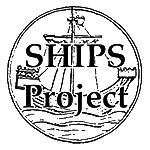'99th Dive'
By Roger Forster, March 2011
My first dive to the James Eagan Layne was my 89th after qualifying with UCNW Bangor sub-aqua club (then an independent dive club), my 99th dive in total. My first open water dive had been at the end of January 1971 at Trearddur Bay on Anglesey in a wetsuit that I had made at home with a roll of neoprene bought from the St. Albans Rubber Company who provided a paper pattern, glue and yellow tape to stick over the seams. Diving then was a bit primitive. It did not put me off.
Eighteen months later in 1972 I was on a 7 week Vacation Engineering Workshop course at the Royal Naval Engineering College at Manadon in Plymouth; HMS Thunderer.
The R.N. sub-aqua club at Manadon decided to dive the James Eagan Layne that day but as there were six people who wanted to go diving it was decided that the Gemini inflatable would go round with the cylinders and two or three divers, the remainder would drive to Whitsand Bay and come down to the beach to be picked up to go diving. That way the Gemini would be on the plane all the way. I had a borrowed Kingfisher demand valve that had a water leak giving me an water air mix with every breath! The Kingfisher had a purge button that stuck out in-front of the DV casing by nearly an inch and could easily be activated accidentally giving one a burst of air unexpectedly.
We launched from somewhere near to the Torpoint ferry and planed round to Whitsand Bay, collected the other divers from the beach and then went out to the James Eagan Layne at a more sedate pace. The dive club moored to the mast that was still sticking out of the water, it had a warning sign telling boat users not to moor to the mast as it was an unstable structure. I was diving with an RN engineering officer called Stuart McHardy. We went down the mast and then down to the seabed on the starboard side in 75 feet of water (pre-metrication of diving). It felt so much deeper then than it does now. Even though I had done nearly a 100 dives it was only my 2nd dive to that sort of depth. Visibility was about 15 feet. After a little time at the bottom (due to the water gas breathing mixture) we came up and over the gunwale and then swam under the forecastle and swam through the holds. The vertical rods supporting the forecastle and the vertical sections between holds in the light were awe inspiring. As a young diver who had never seen a marine engine before I totally missed the engine! Lots of marine life, fish and sponges.
After the dive it was the reverse procedure dropping of the divers we had picked up on the beach and then planing back round to by the Torpoint ferry.
In those days I dived with either a Luxfer 57, charged to 2700 psi, or a US Divers 60 cubic feet cylinder (the norm for those days) charged to 3000 psi (208 bar). For modern metric divers that means the equivalent of about an 8 litre cylinder. With a 60 cubic feet cylinder it was very hard to have a bottom time that took one into decompression! Buoyancy compensators didn't exist so I was using a Spirotechnique ABLJ (horse collar type jacket).
Manadon left me with many memories, not just my first real wreck dive on something looking like a ship (it would be a year later on the Breda at Oban that I would see a wreck that was even more intact). The dawn chorus of peacocks was better than any alarm clock, the East mess bar surface had an OS map of the Plymouth area in Formica with all pubs and night clubs ringed! After dinner we would go to the mess, decide on a pub and off we would go. The Engineering Workshop course was aimed at giving civilian undergraduates an opportunity to experience a wide range of engineering skills. I certainly went home with various things I had made with skills I had learnt. In those days I had a Mini Traveller (850 cc) that boiled as I went up the hill by the Exeter race course, after working on it in the workshops at Manadon it no longer boiled. I learnt a bit about the navy and was given a very positive PR expose of the navy. It even very nearly got me to join up!
I still love the James Eagan Layne. I have been at the bows with my buddy and been unable to see my buddy a few metres away due to an enormous shoal of horse mackerel. I have been attacked by a nesting corkwing wrasse. I have pulled a hooked conger out of its hole and freed it by cutting the line by the hook. What will happen when the James Eagan Layne finally falls apart? What new things will we see? Only time will tell.
![]() If you can provide more information about this then please contact us
If you can provide more information about this then please contact us


